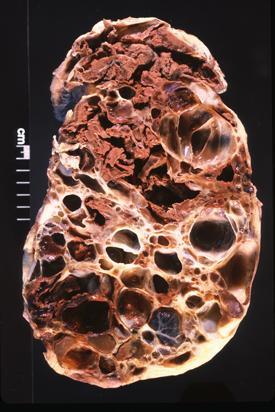The M2 Renal Sequence provides an overview of diseases of the kidney and urinary tract in a clinical setting and provides an introduction to the basic concepts about the area and tools you will need to continue learning about them in future years. The sequence consists of lectures, small group seminars, Clinicopathological Correlation Laboratories, and multidisciplinary conferences on end stage renal disease and organ procurement. Over twenty faculty members from Nephrology, Pathology, Urology, and Pharmacology will participate in the lectures, seminars, and Clinicopathological Correlation Laboratory sessions.
Sequence Directors:
Joel M. Weinberg, M.D.
Paul D. Killen, M.D., Ph.D.
dScribes:
Dannie Chang
Phillip Wang
Syllabus
Overview
The M2 Renal Sequence consists of lectures, small group seminars, Clinicopathological Correlation Laboratories, and multidisciplinary conferences on end stage renal disease and organ procurement. Over twenty faculty members from Nephrology, Pathology, Urology, and Pharmacology will participate in the lectures, seminars, and Clinicopathological Correlation Laboratory sessions. Lectures and Clinicopathological Laboratory sessions are scheduled on successive days to cover a common theme coordinately while allowing time to review and digest the material before the lab session. For the lab sessions, the class is divided in half. They are case-based and jointly taught by both a pathologist and a nephrologist.
Our goal is help you make the transition to dealing with diseases of the kidney and urinary tract in the clinical setting and to provide you with an introduction to the basic concepts about the area and tools you will need to continue learning about them in future years. This is not the last time you will encounter these topics and at subsequent levels of training you will have many opportunities to further refine your understanding of them and your comfort level in applying them to patient care. Some students have found the pace of this sequence and the unavoidable complexity of some of its content to be greater than prior sequences, so it is best to keep up from the beginning rather than to try to make up ground later.
Attendance Policies
The multidisciplinary conferences on end stage renal disease and organ procurement have consistently been among the best rated sessions of the second year. Because they involve outside speakers and patients, attendance is required in order to pass the sequence. Absences must be excused beforehand and will only be approved for significant reasons. Those absent will need to view the videos of the session and, at per specific arrangement with the course director, prepare a two page written summary of the content of the session.
Attendance at lectures, laboratories, and review sessions is otherwise not required, but is highly recommended. We have consistently observed that students who elect not to attend lectures and labs risk performing poorly on the quiz and the final exam. Case histories are presented throughout the course. This format is emphasized in the exam questions and on the national board exam. The opportunities for direct interaction about these cases with the many faculty who participate in the course substantially increases what you will take away from the material.
Exercises
You can also access via CTools three valuable self paced teaching exercises that cover major aspects of the course.
1) Introduction to Renal Pathology
The first pathology lab, “Introduction to Renal Pathology”, is a review of normal renal anatomy and an introduction to renal pathology. It contains an overview of all the essentials and many of the detailed pathology topics that will be covered during the course and pictures illustrative of the main findings. We recommend that you look at it initially on the first day of the course during the afternoon that has been freed for that purpose, although you can access it any time, and then come back to it as the pathology topics are covered during the course.
2) On-line fluid and electrolyte problems from previous Shayman text.
In years past the course used as its text a book edited by one of our faculty, Dr. James Shayman. It is now out of print. However, it had a number of excellent problem sets that have been modified with Dr. Shayman’s kind permission as a web-based teaching exercise that can be accessed via CTools. It is strongly recommended that you do these problems as the topics are covered the first week of the course. They are similar to the problems that will appear on the quiz at the end of that week.
3) Urinalysis exercise
It is organized as a self-paced, self-teaching format. It reinforces many of the concepts presented in the lectures and labs and most of the material in it will be mentioned in the lectures and labs. However, it does include some information relevant to questions on the final exam that for time or other reasons may not end up being covered as clearly or explicitly elsewhere in the course, so we highly recommend that you do the exercise.
Exams, Review Sessions, and Grading
Grading will comply with M2 grading policies established by the Component II Directors and Sequence Coordinators as follows: A pass/fail system will be used, and a cumulative grade of 75% or higher will be required for a passing score. Cumulative grades of 74.99% or lower will be assigned a failing grade.
There are several components to the grading. At the end of the first week a quiz will cover the fluid and electrolyte material. It counts for 30 percent of the total grade so it is important to work from the beginning of the course to master this material. The remaining 70 percent of your grade will be determined by the written final (55 percent) and a laboratory practical exam (10 percent), plus 5 percent credited for the small group seminar the last week of the sequence.
There will not be anything on the exams that has not been specifically mentioned in the lectures, CPCs, problem sets or on-line material provided to you.
Course Review and Quizzes
Fluid and Electrolyte Review and Quiz
A problem-based review session will be held on Friday morning, October 3rd for the fluid and electrolyte material that is covered on the quiz. It will provide an excellent opportunity for you to consolidate your thinking about this material and to prepare for the quiz. It is strongly recommended that you understand the answers to all of the questions for that problem set before the quiz.
The quiz will be available 10/3/08 -10/5/08. It will cover only material presented through 10/5/08 on the physiology of sodium, water, potassium, and acid base, the related lectures on pathophysiology of volume (including the fluid and electrolyte changes in nephrotic syndrome), osmoregulation, hyper- and hypokalemia, hyper- and hypomagnesemia, diuretics, and alkalosis and acidosis, plus information provided during the Electrolyte Review session on 10/3/08. It will not cover the lectures on Glomerular Filtration, Glomerulonephritis, Diabetes, Hypertension, or Acute Renal Failure, but you are responsible for understanding the pathophysiology of the volume and electrolyte changes that occur during nephrotic syndrome for the quiz.
List of lectures covered on the quiz:
- Physiology of Volume Regulation/Heung.
- Approach to Edema and Hypovolemia/Heung.
- Physiology of Water Metabolism/Heung.
- Approach to Osmoregulatory Disorders/Heung.
- Holzman comments on fluid and electrolyte aspects of nephrotic syndrome in “Proteinuria and Non-inflammatory Diseases of the Glomerulus” but NOT ANY GLOMERULAR PATHOLOGY.
- Potassium and Magnesium Homeostasis/Weinberg.
- Approach to Patient with Potassium and Magnesium Disorders/Weinberg.
- Acid Base Physiology/Brosius.
- Approach to Patient with Acidosis or Alkalosis/Brosius.
- Diuretics/Shlafer.
- Fluid and Electrolyte Cases from old Shayman text on the web site.
- Problems in the Electrolyte Review session.
If the cumulative class performance on the quiz is sufficiently high, the final exam will not directly include this material. However, if the course directors determine that additional work on the physiology and pathophysiology of electrolytes and acid base disorders is warranted, then some of this material will be covered on the final exam as well.
End of Course Review and Quiz
A small group seminar will be held the last week of the course on Friday, October 10th. It is a terrific review of material for the final exam. Attendance is not required. However, students who submit their worksheets with answers and who attend will be credited 5 percent toward their final grade. Each year there are several students who will not pass the sequence without this additional credit. We will return your worksheets to your mailboxes later the same day so you can use them to study, but it is advisable for you to also keep your own copy of the sheet with your answers and notes as a backup. We have never misplaced any, but with 175 of them, name changes on mailboxes, etc. that possibility does exist.
A Pathology Review session will be held on Saturday morning, October 11th. It will cover all of the pathology material that has been presented in the course and that can be covered on the final exam.
The final exam available between October 11th and October 13th will consist of the main part of the exam containing approximately 60 questions and a “lab practical” component consisting of 20 questions. The two parts can be taken separately. In the lab practical you will be presented with 10 cases comparable to what you have seen in the afternoon “CPC” sessions containing both clinical history and images of pathology slides. Each of the cases has two questions.
Some tips from a student who developed a very effective strategy to handle the pace of the course and had a perfect score on both the quiz and the exam in a recent year. Previously he had not consistently attended lectures. This sequence he attended almost all. He realized that this is more efficient and the instructors are talking to him and telling him exactly what they want him to know. It is not the same as watching the videos at 2x. He scanned the lecture material in the course pack for 10 minutes before each lecture to know where it was going. In the afternoon or evening the day of the lecture, he reviewed his notes and made a concise summary. For his final review, it was then mainly a matter of going over the summaries.
Texts
There are no required texts, but the following can be helpful to you.
Renal Physiology, 3rd edition by Bruce M. Koeppen and Bruce A. Stanton, Mosby, 2001, the text you used last year for renal physiology has excellent treatment of all the physiology aspects of the fluid and electrolyte and calcium/phosphorus metabolism that will be covered in the sequence. If you used it last year your will find it helpful to quickly review the sections related to the topics in this sequence before the lectures on them. The content of this book and the problems in it, however, have more detail on physiology than needed for this sequence and do not cover some areas of pathophysiology that are essential parts of the sequence, so it should not be the only resource you count on to the exclusion of the new lecture material, various problem sets provided, and the renal pathophysiology text described in the next section.
Renal Pathophysiology, The Essentials, 2nd edition by Helmut G. Rennke and Bradley M. Denker, J.B. Lippincott and Co. is a recent M2-oriented text that follows the sequence of the course quite well. It was published in May 2006, so it is current. It is available at the bookstores and on reserve. It has good fluid and electrolyte problems that can supplement those we provide for the review session and on-line, but you should focus on the ones related to the topics we have covered in lecture.
Additional reading for some of the Pathology lectures and labs can be found in Robbins 7th edition.
For more detailed background at a level geared to residents and fellows, the Primer on Kidney Diseases, 4th Edition, National Kidney Foundation, Academic Press is a current (2005) and readable, brief, but comprehensive text covering all of Nephrology. It is available on reserve in the library.
Reading List
There are no required texts, but the following can be helpful to you.
Renal Physiology, 3rd edition by Bruce M. Koeppen and Bruce A. Stanton, Mosby, 2001, the text you used last year for renal physiology has excellent treatment of all the physiology aspects of the fluid and electrolyte and calcium/phosphorus metabolism that will be covered in the sequence. If you used it last year you will find it helpful to quickly review the sections related to the topics in this sequence before the lectures on them. The content of this book and the problems in it, however, have more detail on physiology than needed for this sequence and do not cover some areas of pathophysiology that are essential parts of the sequence, so it should not be the only resource you count on to the exclusion of the new lecture material, various problem sets provided, and the renal pathophysiology text described in the next section.
Renal Pathophysiology, The Essentials, 2nd edition by Helmut G. Rennke and Bradley M. Denker, J.B. Lippincott and Co. is a recent M2-oriented text that follows the sequence of the course quite well. It was published in May 2006, so it is current. It is available at the bookstores and on reserve. It has good fluid and electrolyte problems that can supplement those we provide for the review session and on-line, but you should focus on the ones related to the topics we have covered in lecture.
Additional reading for some of the Pathology lectures and labs can be found in Robbins 7th edition.
For more detailed background at a level geared to residents and fellows, the Primer on Kidney Diseases, 4th Edition, National Kidney Foundation, Academic Press is a current (2005) and readable, brief, but comprehensive text covering all of Nephrology. It is available on reserve in the library.
Jump to:
| Document Title | Creator | Downloads | License |
|---|---|---|---|
|
10.03.08(b) Lecture Handout: Electrolyte Review |
Department Staff
|
| Document Title | Creator | Downloads | License |
|---|---|---|---|
|
09.22.10: Diabetic Nephropathy |
Frank Brosius
|
||
|
09.26.08: Course Introduction |
Department Staff
|
||
|
09.30.08(a): Physiology of Water Metabolism |
Michael Heung
|
||
|
09.30.08(b): Approach to the Patient with Disorders of Osmoregulation |
Michael Heung
|
||
|
10.01.08: Potassium and Magnesium Homeostasis |
Department Staff
|
||
|
10.03.08(a): Approach to the Patient with Acute Renal Failure |
Department Staff
|
||
|
10.03.08(b): Acid Base Review Problems |
Department Staff
|
||
|
10.07.08(a): Transplant Surgery and Immunology |
Randall Sung
|
||
|
10.07.08(b): Transplant Epidemiology |
Silas Norman
|
||
|
10.08.08: Diseases of the Kidney Upper Urinary Tract |
Stuart Wolf
|
| Document Title | Creator | Downloads | License |
|---|---|---|---|
|
2006 Daily Schedule: M2 Renal |
Dept. Staff
|
||
|
2007 Daily Schedule: M2 Renal |
Dept. Staff
|
||
|
2008 Daily Schedule: M2 Renal |
Dept. Staff
|
||
|
2009 Daily Schedule: M2 Renal |
Dept. Staff
|
| Document Title | Creator | Downloads | License |
|---|---|---|---|
|
09.26.08(a): Renal Introduction |
Aken Desai
Michael Mathis
|
||
|
09.26.08(b): Glomerular Filtration |
Aken Desai
Michael Mathis
|
||
|
09.26.08(c): Physiology of Volume Regulation |
Aken Desai
Michael Mathis
|
||
|
09.26.08(d): Approach to a Patient with Edema/Hypovolemia |
Aken Desai
Michael Mathis
|
||
|
09.26.08(e): Renal Pathology Overview |
Aken Desai
Michael Mathis
|
||
|
09.29.08(a): Proteinurea and Non-inflammatory Diseases of the Glomerulus |
Aken Desai
Michael Mathis
|
||
|
09.29.08(b): Diabetic Nephropathy |
Aken Desai
Michael Mathis
|
||
|
09.30.08(a): Hypertension and the Kidney |
Aken Desai
Michael Mathis
|
||
|
09.30.08(b): Physiology of Water Metabolism |
Aken Desai
Michael Mathis
|
||
|
09.30.08(c): Approach to Patient with Osmoregulation Disorder |
Aken Desai
Michael Mathis
|
||
|
10.01.08(a): Hematuria and Inflammatory Diseases of Glomerulus |
Aken Desai
Michael Mathis
|
||
|
10.01.08(b): Potassium and Magnesium Homeostasis |
Aken Desai
Michael Mathis
|
||
|
10.02.08(a): Mechanisms of Acute Renal Failure |
Aken Desai
Michael Mathis
|
||
|
10.02.08(b): Acid-Base Physiology |
Aken Desai
Michael Mathis
|
||
|
10.02.08(c): Acid-Base Disorders |
Aken Desai
Michael Mathis
|
||
|
10.03.08(a): Diuretic Drugs |
Aken Desai
Michael Mathis
|
||
|
10.03.08(b): Clinical Approach to Acute Renal Failure |
Aken Desai
Michael Mathis
|
||
|
10.06.08(a): Calcium and Phosphorous Metabolism |
Aken Desai
Michael Mathis
|
||
|
10.06.08(b): Chronic Kidney Disease |
Aken Desai
Michael Mathis
|
||
|
10.06.08(c): Hemodialysis |
Aken Desai
Michael Mathis
|
||
|
10.07.08(a): Kidney Transplant and Immunosuppression |
Aken Desai
Michael Mathis
|
||
|
10.07.08(b): Tubulointerstitial Disease |
Aken Desai
Michael Mathis
|
||
|
10.08.08(a): Hereditary Renal Disease |
Aken Desai
Michael Mathis
|
||
|
10.08.08(b): Kidney and Upper Urinary Tract Diseases |
Aken Desai
Michael Mathis
|
||
|
10.09.08(a): Prostate Disease and Pathology |
Aken Desai
Michael Mathis
|
||
|
10.09.08(b): Lower Urinary Tract Physiology and Pathophysiology |
Aken Desai
Michael Mathis
|
||
|
10.09.08(c): Lower GU Pathology |
Aken Desai
Michael Mathis
|




